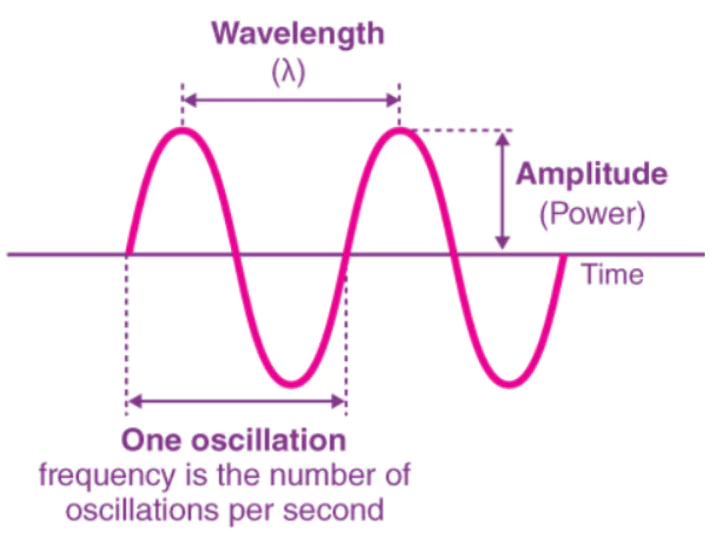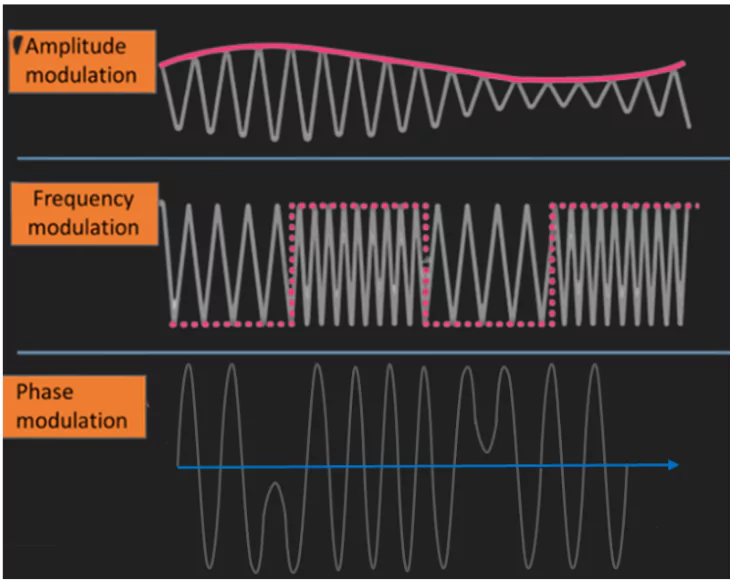Signal modulation simplifies the technologies required to transmit signals carrying information, like the news on TV or songs on the radio.
About Waves
- Waves: A wave is a disturbance or oscillation that travels through space or a medium, transferring energy from one point to another.
 For example, when a pebble is dropped into a calm lake, it creates ripples that move outward in a circular pattern – these ripples are waves, transporting the energy from the pebble’s impact across the water’s surface.
For example, when a pebble is dropped into a calm lake, it creates ripples that move outward in a circular pattern – these ripples are waves, transporting the energy from the pebble’s impact across the water’s surface.
- Wave’s Amplitude: Amplitude refers to the height of a wave, measuring the maximum displacement from its rest position. It determines the energy of the wave.
- For instance, if you drop a large stone into the lake, the resulting wave will be taller than if you dropped a small pebble. Similarly, a sound wave with a high amplitude will be louder, and a light wave with a high amplitude will be brighter.
- Frequency: Frequency is the number of wave cycles (crests and troughs) that pass a specific point per second, measured in hertz (Hz).
- Signal Modulation: It is the process of altering a carrier signal’s properties, such as amplitude, frequency, or phase, to encode and transmit information.
- This technique allows efficient communication by converting the information into a format suitable for long-distance transmission.
Enroll now for UPSC Online Classes
About AM FM and Phase Modulation
- Frequency Modulation (FM): In frequency modulation, the frequency of the carrier wave is varied based on the information being transmitted, while its amplitude remains constant. Imagine a violin string being plucked—if you tighten or loosen the string, the frequency of the sound changes, but its loudness stays the same.
- Key Characteristics:
- Frequency of the carrier wave varies with the signal and amplitude remains constant.
- Resistant to noise and interference.
- Requires more bandwidth than AM.
- Usage: FM is widely used in FM radio broadcasting because it reduces interference from noise.
- Amplitude Modulation (AM): In amplitude modulation, the amplitude of the carrier wave is varied to reflect the information signal, while its frequency stays the same. A good example is adjusting the volume on a speaker—the frequency of the sound remains unchanged, but the loudness (amplitude) increases or decreases.
- Key Characteristics:
- Amplitude of the carrier wave varies with the signal and the frequency remains constant.
- Susceptible to noise and interference.
- Simpler technology with a lower bandwidth requirement.
- Usage: Used in AM radio broadcasting and long-distance communication (e.g., aviation communication).
 Phase Modulation (PM): Phase Modulation is a technique where the timing or position of the wave’s cycle is changed to carry information. Instead of changing the wave’s amplitude or frequency, PM adjusts where the wave starts within its cycle. This change in the starting point of the wave is how the message is encoded.
Phase Modulation (PM): Phase Modulation is a technique where the timing or position of the wave’s cycle is changed to carry information. Instead of changing the wave’s amplitude or frequency, PM adjusts where the wave starts within its cycle. This change in the starting point of the wave is how the message is encoded.-
- Key Characteristics:
- Phase of the carrier wave varies with the signal but frequency and amplitude remain constant.
- Resistant to noise, especially in digital communication.
- Usage: PM is preferred in digital transmission like Wi-Fi due to its resistance to noise, as slight amplitude changes don’t degrade the signal.
- Widely used in digital communication systems like Wi-Fi, satellite communications, and GPS.
Analog versus Digital Signals
| Parameter |
Analog Signal |
Digital Signal |
| Definition |
An analog signal is a continuous, time-varying signal that represents information as a continuous range of values. It is smooth and flows without interruption. |
A digital signal is a discrete, non-continuous signal that carries information using binary values (0 and 1). It jumps between distinct values. |
| Information Representation |
Infinite range of values, meaning it takes every possible value within a given range at any moment. |
Discrete values, typically represented by two states (0 and 1). |
| Power Requirement |
Typically consumes more power during transmission. |
Lower power consumption as compared to analog systems. |
| Usage |
Used in devices like analog radios, older TV broadcasts, and in sound recording systems. |
Commonly used in modern electronics like computers, digital phones, and communication systems (Wi-Fi,CDs, etc) |
| Accuracy |
Analog signals provide a more accurate representation of real-world data because they can take infinite values |
Digital signals, while more resistant to interference, provide a less accurate representation due to their discrete nature |
Significances of Signal Modulation
- Efficient Use of Channels: Modulation allows multiple signals to be transmitted simultaneously over the same channel, such as in radio waves or fiber-optic cables, without interference.
- Noise Reduction: Modulation helps minimize the impact of external noise ( static from lightning) on transmitted signals, ensuring clearer communication, especially for digital transmissions.
- Extended Transmission Range: Modulation techniques like AM allow signals to travel long distances, even over physical obstructions like mountains, due to the longer wavelengths involved.
- Improved Signal Quality: Modulation methods like FM provide superior sound quality by reducing the effects of static, though they require more bandwidth and have shorter transmission ranges.
- Frequency Allocation: Modulation enables efficient use of frequency bands, reducing signal interference. International organizations like the International Telecommunication Union allocate these frequency bands for different communication services.
- Shift to Digital Broadcasting: As technology advances, there is a shift from analog to digital broadcasting, which provides clearer signals, less interference, and more efficient data transmission, though initially at a higher cost.
Check Out UPSC NCERT Textbooks From PW Store
![]() 16 Sep 2024
16 Sep 2024
 For example, when a pebble is dropped into a calm lake, it creates ripples that move outward in a circular pattern – these ripples are waves, transporting the energy from the pebble’s impact across the water’s surface.
For example, when a pebble is dropped into a calm lake, it creates ripples that move outward in a circular pattern – these ripples are waves, transporting the energy from the pebble’s impact across the water’s surface. Phase Modulation (PM): Phase Modulation is a technique where the timing or position of the wave’s cycle is changed to carry information. Instead of changing the wave’s amplitude or frequency, PM adjusts where the wave starts within its cycle. This change in the starting point of the wave is how the message is encoded.
Phase Modulation (PM): Phase Modulation is a technique where the timing or position of the wave’s cycle is changed to carry information. Instead of changing the wave’s amplitude or frequency, PM adjusts where the wave starts within its cycle. This change in the starting point of the wave is how the message is encoded.